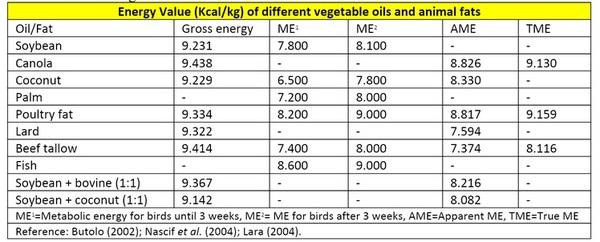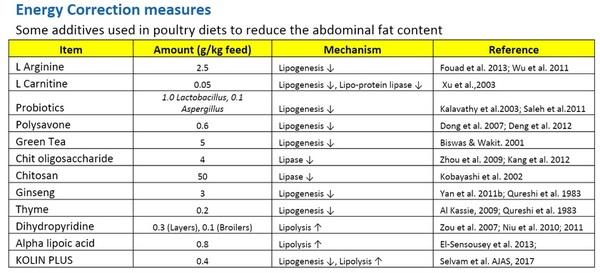Unseen Challenges in Balancing Fat in Poultry Nutrition
- The presence of fat in the diet inhibits the synthesis of fat from carbohydrates. The final composition of body fat is a pondered average among the fat produced endogenously from glucose, the quantity and composition of the fatty acids in the diet and the fat resulting from catabolism through b-oxidation (Ajuyah et al., 1991; Ferreira, 1999, Sanz et al., 2000b).
- Female broiler chickens tend to deposit more fat than male broiler chickens. Quantitative feed restriction for 10 days (beginning on the first day in the second week of age for female broiler chickens) led to a significant reduction in the abdominal fat % and total body fat deposition.
- Adding fat to feed as an isoenergetic substitution for carbohydrate usually results in an improved productive energy when the same level of MEn has been derived.
- Providing dietary fat decreases the need for hepatic fatty acid synthesis and generally increases yolk formation and the weight of the egg (Whitehead, 1981)
- During high environmental temperatures, as feed intake is reduced, the added fat permits hen to maintain egg formation while minimizing heat generation (Valencia et al.,1980).
- Replacement of tallow by vegetable fats rich in polyunsaturated fatty acids like sunflower oil, soybean oil, or linseed oil resulted in a decrease of abdominal fat deposition in broilers (Newman et al., 2002; Ferrini et al., 2008; Wongsuthavas et al., 2008).
- The apparent digestibility of the fat is high during the first week of age, low on the second and high after the third week of life.

- Improves the absorption of fat-soluble vitamins.
- Decreases dustiness of feeds and reduced dust losses.
- Increases diet palatability.
- Reduces the rate of food passage through the gut, in turns better nutrient absorption.
- Lower heat increment during heat stress keeps caloric intake up.
- Concentrated feeds can decrease transportation costs for feed delivery.
- Use of higher levels of fat may negate the effects of pelleting
- Potential for rancidity
- Poor digestibility of saturated fats by the young bird
- Measurement of metabolizable energy (ME) content can be difficult



- Reducing the energy level from 3,200 to 3,000 kcal/kg in broilers from 21 to 42 days significantly reduced the abdominal fat % & total body fat deposition without any negative effects on daily gain, feed intake or dressing %. (Kassim and Suwanpradit; 1996).
- L-methionine supplementation regulates the body fat content by reducing the activity of FAS (lipogenesis) and increasing the activity of hormone-sensitive lipase (HSL) (lipolysis). (Corzo et al.2006, Yao et al.2006, and Zhan et al.2006).
- Lysine improves meat quality (Lean meat) by enhancing muscle pH, increasing protein deposition, and reducing water-holding capacity.(Berri et al.2008; Tesseraud et al., 2009).
- 1% additional arginine above the NRC (1994) recommendations reduced the abdominal fat content and carcass fatness by decreasing the activities of malate dehydrogenase (MDH), G-6-PDH, and FAS (lipogenesis).
- Manganese (Mn) significantly reduced the carcass fatness by downregulating the activity of lipoprotein lipase (LPL) in the abdominal fat. (Klimis-Tavantzis et al., 1983).
- Inclusion of 1.5% conjugated linoleic acid (CLA) in broiler diets significantly reduced the abdominal fat & skin fat by downregulating peroxisome proliferator-activated receptor g (PPARg).Zhang et al; 2007, Royan et al; 2011).
- Betaine lowered the body fat content in broilers by increasing the activity of HSL and reducing the activities of FAS and LPL in the abdominal fat. (Wang et al.2004; Zhan et al;2006).
- L-Carnitine transports long-chain fatty acids across the inner mitochondrial membrane during beta-oxidation (the first step in fatty acid oxidation: catabolism), L-carnitine supplementation decreases abdominal fat deposition in meat-type poultry by reducing the activities of G-6-PDH, MDH (lipogenic enzymes). (Xu et al;2003).
- Polyphenols significantly reduced abdominal fat traits by inhibiting hepatic lipogenesis (Biswas and Wakit, 2001).
- Dihydropyridine (100 mg/kg)in broiler diets from 1 to 42 days of age was enough to suppress the activities of LPL in abdominal fat, as well as MDH and G-6-PDH in the liver, thereby reducing the abdominal fat percentage. (Niu et al; 2010).

Alvaro Dubois, these considerations are pertinent and raise some important points to be considered with the use of fat in the diet of chickens exposed to a high temperature environment. There is a detail that I think deserves some more consideration. Regarding the use of fat, even in the condition in which the metabolizable energy of the feed is maintained, there must be an increase in the deposition of fat in the chicken carcass. This is related precisely to the fact that the fat for providing less caloric implement increases the net energy of the feed, and consequently can result in a greater amount of deposited fat. With regard to feed protein, the practice of reducing it in heat, using the concept of ideal protein, with industrial amino acid supplementation, also increases the net energy of the feed and may increase the concentration of fat in the carcass of birds. I agree with Dr Alvaro, that in hot conditions the responses of the chickens to nutritional changes are normally less expressive when compared to those of the chickens in thermoneutrality.


E.S.E. & INTEC




North American Renderers Association (NARA)









